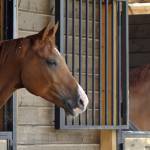Management of Horses with Chronic Obstructive Pulmonary Disease

Chronic obstructive pulmonary disease (COPD) is characterized in horses by chronic cough, increased respiratory rate, forced abdominal breathing, and exercise intolerance. Feeding and housing management play a critical role in the perpetuation of COPD in horses. Specifically, dusts and molds contained within horse feed and bedding can trigger the allergic responses within the lung that ultimately result in development of COPD. Therefore, management of affected horses is heavily reliant on measures that minimize exposure to these airborne irritants.
It is important to recognize that there is no cure for COPD. However, in all but the most severe cases, management and treatment measures can result in marked clinical improvement and minimize the number of further episodes. The most important component of treatment is environmental control to reduce exposure of the horse to the aeroallergens and other pollutants that cause the airway inflammation. Keeping the horse at pasture, without exposure to hay and straw, is by far the most effective means of environmental control. Indeed, in horses with signs of COPD, significant improvement in lung function can occur within three days of changing from a stable to a pasture environment.
If the horse must be stabled, removing dry hay from the diet is the most important aspect of environmental control. In mild cases, soaking the hay prior to feeding is often effective in reducing dust levels in the horse’s breathing zone. The hay must be thoroughly soaked, preferably by immersing the hay in a large tub of water for 10 to 15 minutes. Dry areas in a poorly soaked hay portion can release enough mold spores to cause an allergic reaction. This process should be done no sooner than 20 to 30 minutes before feeding to avoid leaching of water-soluble nutrients from the hay.
A much less labor-intensive approach involves use of alternative forages such as hay cubes, haylage, or complete pelleted feeds.
Bedding is the other major source of dust and mold spores in a barn. COPD horses should not be bedded on straw. Shredded paper, wood shavings, rubber mats, or peat moss should be used. It is also preferable to bed the stalls adjacent to the one used by the affected horse with the same bedding, although recent studies have demonstrated that clinical improvement occurs even when management changes are made only in the stall of the affected horse.
Horses should be turned outdoors during stall cleaning and rebedding to minimize exposure to dust. Barn ventilation is another consideration in optimizing the horse’s environment. The buildup of ammonia, endotoxins, and other noxious agents can worsen the disease and delay recovery, even when other treatment measures have been instituted.
In mild cases, environmental management alone may effectively control the disease. However, horses with moderate to severe signs of COPD will also require medical treatment, at least initially. Treatment will often involve combined use of bronchodilator and corticosteroid drugs. Bronchodilator drugs (e.g., clenbuterol) are particularly indicated for horses experiencing an acute “heaves” attack. Relief of bronchospasm will result in marked clinical improvement. However, this relief is short-lived and longer term drug therapy must be directed at reducing airway inflammation. This is achieved through use of corticosteroid drugs.
Although environmental management will always be the most important factor in the control of COPD, some horses will require long-term treatment with corticosteroids to control the underlying airway inflammation.
Read more from Advances in Equine Nutrition III.








